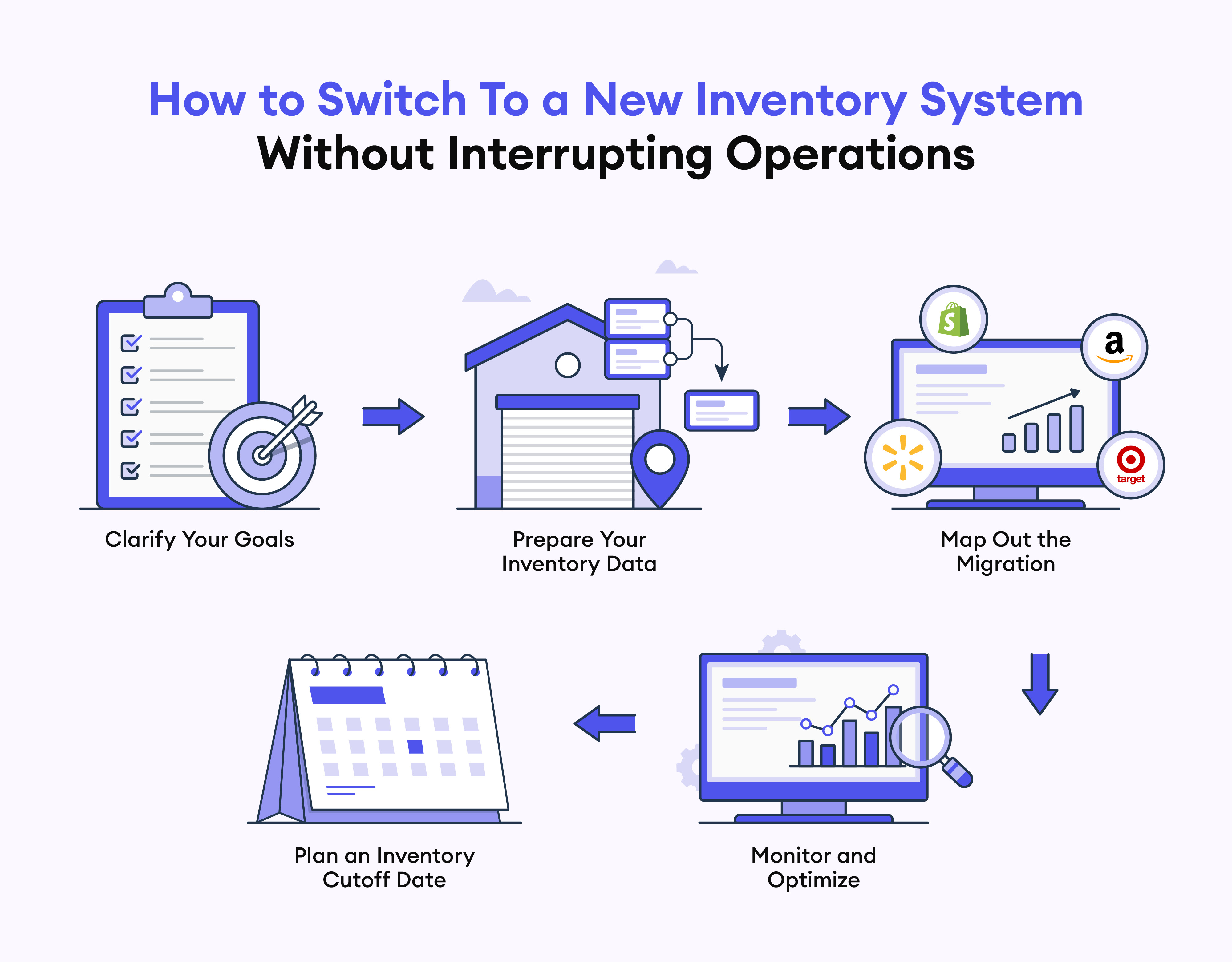How to Switch To a New Inventory System Without Interrupting Operations

Switching to a new inventory system can feel a lot like swapping engines mid-flight. You know you’ll fly faster and more reliably once it’s done, but the thought of doing it without everything falling apart can be intimidating.
Why make the leap at all? For most sellers, it comes down to growth and complexity. Maybe spreadsheets and manual counts worked when you were managing a few SKUs and one sales channel. But as you expand to marketplaces like Amazon or Walmart, add new warehouses, or manage thousands of SKUs, those old systems start to show cracks. Delays, overselling, and missing data creep in. Suddenly, you’re spending more time putting out fires than focusing on growth.
The truth is, many businesses wait too long to switch because they fear the disruption. But a modern inventory system doesn’t just keep you afloat; it makes scaling sustainable. With the right preparation, you can migrate smoothly, avoid costly downtime, and finally get the automation, visibility, and control your business has been missing.
Step 1: Clarify Your Goals
Before you dive in, get crystal clear on why you’re switching. Are you looking for:
Faster order processing?
A system that scales with your business?
Better automation across channels?
Seamless integrations with marketplaces, warehouses, and carriers?
Write down the pain points with your current setup and what “success” looks like after migration. For example: “We want to eliminate overselling, improve reporting accuracy, and streamline multi-channel management.” These goals will guide your entire rollout.
Step 2: Prepare Your Inventory Data
No system can fix messy data. That’s why your first job is to clean house:
Audit all SKUs, quantities, and warehouse locations.
Remove duplicates and outdated SKUs.
Correct bad records before they create problems.
But don’t stop there. Look for hidden pitfalls like “ghost inventory” (stock that shows as available but doesn’t physically exist), stranded units in Amazon FBA, or mismatched SKUs across different channels. These discrepancies cause major headaches during migration if left unchecked.
Another best practice: standardize your SKU naming conventions. If the same product is called “Sneaker-001” in Shopify and “RedSneakersSize9” in Amazon, it creates confusion and errors during sync. Decide on a clean, consistent system before you migrate, and your new software will have a solid foundation to build on.
Think of this prep step as laying the foundation for a house. If it’s crooked or cracked, everything built on top of it will wobble. Take the time now, and the rest of your migration will run much smoother.
Note: If you’re not using a Perpetual Inventory system, you’ll struggle to achieve the accuracy you need to make a seamless switch. Check out our helpful guide: Why Perpetual Inventory Is The Only Viable Solution For Modern Ecommerce Businesses.
Step 3: Map Out the Migration
Next, chart out every system that touches your inventory. This includes:
Sales channels (Amazon, Walmart, Shopify, Target Plus)
Warehouses and 3PLs
Accounting software
Shipping carriers
Once you’ve identified all the connections, map out how they’ll flow through your new system. Connect these integrations in Goflow before your launch so nothing slips through the cracks.
For example: sales channels feed into Goflow → Goflow updates warehouses and carriers → warehouse updates flow back into Goflow → Goflow syncs with accounting. Seeing the full loop makes it easier to spot gaps before they cause issues.
Then, work with your vendor or implementation team to decide how the data will transfer: bulk upload, API sync, or a phased transition. Where possible, run test connections in a sandbox environment before going live. Upload a handful of SKUs, run a test order, and see how the data flows. These dry runs give you confidence and reduce surprises on migration day.
And remember: always back up your existing data before making changes. If anything goes wrong, you’ll have a clean record to fall back on.
Step 4: Plan an Inventory Cutoff Date
Here’s where planning really matters. Pick a cutoff date to switch from the old system to the new one. Ideally, choose a period of low sales volume. Slower hours or off-peak days are best.
On cutoff day:
Freeze all activity in the old system (receiving, transfers, sales, etc.).
Do a final count across warehouses. Validate on-hand stock, check backorders, confirm items in transit. This snapshot becomes the baseline in Goflow.
Sync all outstanding activity before migration: open sales orders, POs with expected receipts, and flagged backorders.
After the cutoff, all activity happens in Goflow only. The old system is now reference-only.
On the next business day, validate carefully:
Check available inventory vs. orders.
Confirm shipments deduct correctly.
Verify POs received update counts.
Catching discrepancies early keeps your rollout smooth.
Step 5: Monitor and Optimize
Once you’re live, don’t just set it and forget it. Monitor performance closely:
Track order accuracy, stock visibility, and fulfillment speed.
Collect feedback from your team on new workflows.
Make small adjustments as needed.
With Goflow, you can run real-time reports to catch issues before they snowball, helping your operations stay steady even as you scale.

Mistakes to Avoid
Watch out for these common missteps:
Migrating messy or incomplete data. If you move over duplicates or errors, your new system will just inherit old problems. Always audit and clean first.
Switching during peak sales periods. Trying to migrate during Black Friday or the holidays is a recipe for chaos. Pick a calm season when order volume is manageable.
Skipping staff training. Your team is the one using the new system daily. Without training, adoption is slow, errors multiply, and frustration grows. Schedule hands-on training sessions and create simple process guides.
Forgoing a testing phase. Jumping straight to live without trial runs is risky. A pilot phase with limited SKUs or channels lets you identify issues in a controlled environment before they affect your entire business.
By sidestepping these mistakes, you’ll avoid the pitfalls that derail many migrations, and you’ll set your team up for long-term success.
The Bottom Line: Switching Systems Can Transform Your Operations
Switching systems might feel daunting, but sellers do it successfully all the time, and most say they wish they’d done it sooner. The rewards are too significant to ignore: cleaner operations, better customer experiences, and the ability to scale without the constant stress of manual workarounds.
When you take the time to prepare your data, map your integrations, and train your team, the transition doesn’t just protect your current operations, it unlocks new potential for growth. Instead of juggling spreadsheets or scrambling to fix errors, you’ll have real-time visibility, automation, and control at your fingertips.
In today’s competitive ecommerce market, efficiency isn’t a nice-to-have; it’s survival. For more on this, check out this helpful post: Work Smarter, Not Harder: The Power of Automation for Inventory Management.
A modern inventory system like Goflow makes switching less of a gamble and more of a growth strategy. Ready to simplify your switch? Book a live demo and see how Goflow keeps your operations running smoothly, even during big changes.
